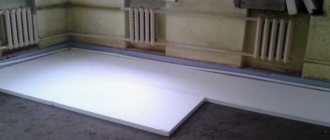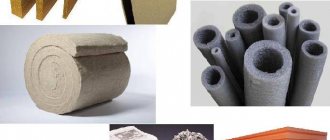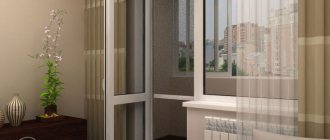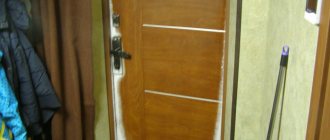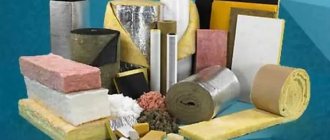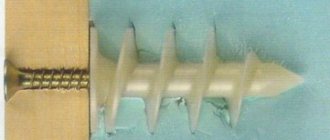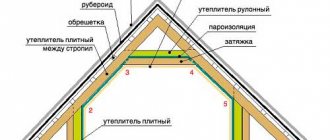Owners of corner apartments especially often face problems such as excessive dampness or cold. The heating system does not always work efficiently. Therefore, it is important to know how to insulate a wall in a corner apartment from the inside and minimize energy loss. With the right approach, it will be possible to significantly improve the indoor microclimate and make it more comfortable for living. In this material we will tell you how to properly install insulation and what is required for this.
Why insulate a corner apartment?
The layout of corner apartments in terms of energy consumption for heating is not the most optimal due to the presence of two external walls. And as a rule, in such conditions, even the presence of additional heating devices does not save residents from the cold. Before the heating season, when the temperature outside drops sharply, heat begins to quickly leave the room, which is why the apartment becomes cold, dampness and fungus appear. If the walls are not insulated, it will be uncomfortable to be in such a room.
Freezing corner in the apartment
When the central heating comes on, the situation improves slightly as it becomes warmer, but corner walls can freeze. This leads to damage to the plaster layer and peeling of the wallpaper. As a result, mold and various types of fungus begin to develop in such places. Such a microclimate causes discomfort and does not have the best effect on the health of residents. Due to the dampness and low temperatures, colds are becoming a common occurrence for many residents of corner apartments.
A little theory: dew point
In construction, the concept of “dew point” is used.
The dew point is the temperature at which condensation forms (moisture from the air turns into water droplets). In relation to the enclosing structures of a house, such a point can be located both on the surfaces of the wall from the outside or inside, and in its thickness.
During periods of high air humidity and low temperatures, the microclimate of the apartment contributes to the formation of condensation. Due to an incorrectly located dew point, mold and mildew begin to develop on the walls. It is better to insulate them from the outside. This approach will make the walls inside the room warmer and move the dew point to its outer edge. This will help get rid of mold and mildew. If it is not possible to thermally insulate the apartment from the outside, then it is possible to insulate the end wall from the inside. In this case, you need to select the insulation so that the dew point is in the thickness of the supporting structure.
Visual optimal dew point position
Insulating the walls will help make the room warmer and get rid of dampness. The microclimate will become much more comfortable, and residents will not have to worry about their health. However, it is important to properly insulate the room so that the result is as effective as possible.
Which material to choose - mineral wool or polystyrene foam?
When choosing insulation, you need to take into account the characteristics of the room. Any material must have the following properties:
- fire resistance;
- environmental friendliness (in the case of internal insulation, this factor plays a key role);
- ability to absorb moisture;
- high thermal insulation and breathability properties.
Mineral wool
Mineral wool is made from basalt and is the most popular material for wall insulation. It retains heat well inside the room, but easily allows air to pass through, which ensures good ventilation. The air in the room is always fresh and does not stagnate, which also allows you to get rid of high humidity. The material is highly elastic, which is convenient for installation. However, over time, basalt wool tends to deform, absorbing excess moisture. Therefore, when installing mineral wool, a sheathing is installed.
For basalt wool you will definitely need a frame
Other disadvantages include harm to the respiratory system. When used indoors, the degree of toxicity is not very high, but still the material is more suitable for outdoor use. Another disadvantage is considered to be increased weight.
Styrofoam
The main advantages of polystyrene foam are its cost and high thermal insulation ability. The material perfectly allows air to pass through, it is lightweight and convenient for installation work. It is non-toxic, which makes it excellent for interior decoration. The low weight will allow all work to be carried out independently without the involvement of builders. Particularly effective for internal insulation. However, there are also disadvantages. Polystyrene foam is highly flammable and is also not suitable for insulating wooden structures, since condensation will form on such surfaces.
Installation of foam plastic boards
How can you insulate the walls of a corner apartment?
Before we begin to consider insulation methods, we draw the reader’s attention to an important circumstance: in addition to thermal energy, a small part of the water vapor present there also leaves the room through the wall.
So that it can freely come out, and not settle inside the structure in the form of condensation, the vapor permeability of all layers in the direction of movement, that is, from the inside to the outside, must increase.
Is it possible to break this rule? It’s possible, but then the inside of the wall needs to be covered with a vapor barrier film, and the ventilation needs to be made more efficient, since now the task of removing excess moisture will entirely fall on it alone.
Now we will consider two methods of insulation: from the inside and from the outside.
Insulation from outside
This method is the most preferable, since when placing the insulation on the outside, freezing of the wall will be prevented, and therefore the harmful effects of freeze-thaw cycles on it.
A reinforced concrete wall of a panel house, the vapor permeability of which is 0.03 mg/m*h*Pa, can be insulated with expanded polystyrene foam, that is, ordinary polystyrene foam. For a brick wall (0.11 - 0.17 mg/m*h*Pa), it would be desirable to use stone wool. But in a limited area it is quite difficult to protect it from atmospheric moisture.
Therefore, we will also insulate the brick wall with foam plastic. To prevent dampness from appearing on its outer surface, we will cover the inside of the wall with a vapor barrier film or cover it with vinyl wallpaper (they do not allow steam to pass through).
Did you know that in most cases, rooms are insulated from the outside? Is it possible to insulate a house from the inside - consider the arguments for and against.
The technology for making ecowool with your own hands is described in detail in this article.
Installation
The wall must be treated with an antiseptic, after which a starting profile made of galvanized steel is screwed along the lower border of the insulated area.
The profile must be fixed strictly horizontally (set according to the building level).
Next, in the upward direction from the starting profile, we begin to install foam sheets 5–10 cm thick.
Each sheet must first be placed on tile adhesive, and then screwed with 5 (4 in the corners and 1 in the center) dowels of a special type - the so-called “umbrellas”. They have a large diameter cap, which when twisted does not press through the foam.
It is better to lay the insulation in 2 layers, so that the seams of one layer overlap the slabs of the adjacent one.
Finishing
Using a wide spatula, apply a thin layer of tile adhesive to the thermal insulation made of polystyrene foam, on top of which fiberglass is laid. It should be laid with an overlap and at the same time be slightly recessed in the glue. You can apply another adhesive layer on top so that the canvas relief does not appear on the plaster.
The insulating layer on top should be protected with a galvanized sheen or at least puttied. Then they begin to finish the main surface - lay structural plaster on it, then paint it.
Insulation from the inside
A very unsuccessful method of insulation, but in some cases it is the only possible one. For example, if the apartment is located above the first floor and you do not intend to spend money on renting a tower, or if there is a neighboring building right behind the wall.
Let's decide on the type of heat insulator:
- If the wall is brick, you can lay the same polystyrene foam - its vapor permeability is lower than that of brick.
- The wall of a panel house must be insulated with extruded polystyrene foam, whose vapor permeability coefficient is only 0.005 mg/m*h*Pa.
In both cases, you can use basalt wool, but then the inside will need to be covered with a vapor barrier.
In the case of internal insulation, it is better to place the insulation on the frame rather than screw it or glue it to the wall. In this case, firstly, it will be possible to mount shelves, holders for flower pots, etc. on the wall; and secondly, easy access to the contact area between the insulation and the wall will be provided.
It is here that, as a rule, the steam that has penetrated the wall turns into condensation, and when installing the insulation on the frame, this can easily be checked.
Features of insulation of corner apartments of a panel house
The process of installing panel wall railings is different for finishing walls indoors or outdoors. Let's take a closer look at the main differences.
The nuances of installing thermal insulation from inside the room
In a panel house, when installing internal insulation, the material must be laid on bare walls, which is why it is better to carry out the procedure during a major overhaul. Installation work begins with the installation of a waterproofing layer, which is most often a polyethylene film with special breathable membranes. It is best to use a single piece of film over the entire surface of the wall. A metal frame is installed on the waterproofing layer. After installing the sheathing, sheets of insulating material are installed.
An example of internal insulation of an apartment corner with mineral wool over a steel frame
Installation from the outside of the panel
When carrying out work on the outside of the room, initially all foreign objects are removed from the surface of the walls, and their surface is thoroughly cleaned. The lathing is installed directly on the surface of the walls. Next, two layers of waterproofing are installed with a layer of vapor barrier between them. Sheets of the main insulation are installed on top. The outside is decorated with decorative cladding.
Carrying out work
The insulation process consists of installing a dense layer of heat insulation on the entire surface of the external walls. A feature of insulation is the need to install protective and decorative sheathing on top of the insulation, which requires the creation of a supporting structure - sheathing. It consists of a series of strips forming a vertical plane located at a distance from the wall equal to the thickness of the heat insulator. It fits tightly between the sheathing strips, forming a continuous layer with no gaps or gaps.
Insulation of corner apartments requires the installation of thermal insulation on two adjacent walls, which increases the consumption of sheathing, insulation and vapor barrier. In addition, the total amount of work increases. It will be necessary to efficiently and hermetically insulate the junction of the two walls.
Procedure:
- Surface preparation. All foreign objects, hanging lamps, brackets, flower beds, etc. are removed from the wall.
- The walls are marked and the attachment points for the sheathing strips are determined. The markings should take into account the width of the insulation and the sheathing strips, so that the heat insulator does not have to be adjusted later.
- Installation of sheathing. Wooden blocks or metal guides for drywall are used. Installation of metal elements is more convenient and allows you to obtain an exact distance from the wall corresponding to the thickness of the insulation. At the same time, metal parts are capable of creating so-called cold bridges, forming pockets of condensation. Wooden planks do not form cold bridges, but require great precision in installation.
- Installation of vapor barrier. This item is only necessary when using mineral wool. The vapor barrier is an ordinary polyethylene film (you can take a standard sleeve). Installation is carried out in horizontal stripes. The first row is from below, the next one overlaps at least 10 cm above it - and so on until the wall area is completely covered. The joints of the film must be taped with construction tape. Installation is carried out on top of the sheathing strips, the film is crumpled around them and fits tightly to the wall.
- Installation of heat insulator. Plates (or cut pieces) of material are tightly inserted between the sheathing strips. You should keep a can of polyurethane foam on hand to immediately fill cracks or gaps if they appear. Some experts recommend covering all edges of the insulation with foam to seal even the smallest cracks.
- A second layer of waterproofing is installed on top of the heat insulator. For impermeable materials, a polyethylene film is suitable, but for mineral wool it is better to use a vapor-waterproofing membrane. It has the ability to pass water vapor in one direction. When installing, you must carefully ensure that the material allows steam to escape from inside the resulting cocoon. This will ensure that the insulator dries out if water gets into it in any way.
- After this, a layer of protection is attached to the surface of the sheathing planks. Actually, the sheathing is installed precisely so that there is a supporting structure for installing the sheathing. Sheet materials commonly used are plywood, plasterboard or the like. Some owners prefer clapboard or wall panels. The choice is determined by the capabilities and preferences of the owner.
Stage of installation of waterproofing for internal wall insulation
One of the options for installing a protective layer is to apply plaster. The work involves the use of wet solutions and requires some time to dry, but the result is quite decent, masking the work done in the best possible way. If you plan to use plaster, you can do without lathing. The insulation is tightly installed on the wall using an adhesive composition, after which a fiberglass reinforcement mesh is attached to the surface and a layer of plaster is applied. This option is best used if penoplex is used as insulation. The ability to avoid installing sheathing allows you to use fairly thin insulation while maintaining the volume of the room. Work in the area of radiators and risers of the heating system is simplified, and insulation of the window opening becomes easier.
The use of warm plaster is one of the effective ways to reduce heat loss
After installing the sheathing, finishing is done. All work is carried out indoors, so it does not depend on the time of year or the weather outside. No permits are required for internal insulation; these actions do not constitute redevelopment or even reconstruction of residential premises.
Insulating a room in a panel house
In panel houses, the main problem areas are interpanel joints. Insulation will not be effective enough if the joint is not first sealed, which requires opening it as much as possible along the entire length of the wall. Typically, slab joints are sealed with tow, plaster or plaster. The gap must be opened as much as possible using a spatula or narrow chisel. Remove old tow, filler or other material. Then you need to inspect the resulting gap and determine its depth. The best option would be to fill the joint with foam. This is not difficult, is done quickly enough and allows you to effectively seal the joint.
It is important! After the foam has hardened, the parts protruding from the crack are carefully cut with a knife to form an even angle. Further work is carried out according to the general insulation technology.
Insulating a room in a brick house
The brickwork is well tied at the corner joints and has no gaps with access to the outside. This allows you to carry out work without preliminary insulation of the connection of planes. In this case, the properties of the material require hydrophobization before installing the heat insulator. To do this, the brick wall to be insulated is cleared of a layer of plaster over the entire area. After this, the surface is covered with a layer of water repellent using a brush or roller. It is necessary to use deep penetration material for interior work. Some types require application in several layers, as described in the instructions on the package. After the composition has dried, a heat insulator is installed on the surface of the walls using conventional technology.
Nuances of internal installation
Foam plastic is most often used for internal wall insulation in brick houses. Before installation work begins, any finishing is removed. The surface is carefully plastered and then treated with a primer. It is very important to apply the primer in an even layer so that cracks do not begin to form after drying.
The insulation sheets are installed on the still damp material. The insulation material is attached using construction adhesive. It is very important to pay attention to the components of the composition. The adhesive material should not emit toxic fumes.
Video: example of thermal insulation of an apartment with Penoplex slabs
Insulation from the outside
For exterior work, mineral wool is most often used. The start of work follows a similar algorithm. On the outside, the panels are protected with an additional layer of primer to resist weathering, and a decorative finish is applied over the protective layer.
The corner apartment of a brick house is insulated from the outside
A brief overview of foam brands for insulating walls from the inside
In building materials stores you can see a fairly large assortment of foam brands. Let's look at the most common of them. Regardless of the brand, there can be two types of marks on the box: “PS” and “PSB”. The first indicates that the material was made using the pressing method, the second - the non-press method.
A popular brand of polystyrene foam is C-15. This type is produced using a non-press method. Due to its high density, it is excellent for both indoor and outdoor use. However, foam plastic of the S-25 PSB brand is best suited for insulating corner apartments. This is a higher density material that can also be used for floor insulation. The S-35 PSB grade is characterized by excellent resistance to extreme weather conditions. It is characterized by high fire resistance, as well as the ability to easily withstand mechanical damage. The densest variety is the S-50 PSB. This is a fairly expensive material, which is usually used in cases of frequent hail and constant strong wind.
For internal insulation, only the first two options are used.
A brief overview of mineral wool brands for insulating walls from the inside
There are four most popular varieties of mineral wool: P-75, P-125, PPZh-200 and PZh-175. For interior work, only the first two varieties are used. Cotton wool P-75 is the lightest and has a relatively low density. P-125 is more rigid and is used for interior decoration in cold climates. The last two types, due to their increased density, are used only for outdoor work.
The best manufacturers of insulation materials are: Isover, Isorok, Ursa, and Rockwool.
Features of insulation in brick houses
At the beginning of work, you need to protect the surface and apply a primer with antifungal components. When insulating with mineral wool, a frame is built from slats, and pieces of material are placed between them on glue. Glue is applied to the wall, the seams are covered, and rubbed. Then gypsum board, primer, paint, and wallpaper are laid.
When working with polystyrene foam, the glue is applied with a spatula. There should be no gaps left; they are reliably coated with sealant. The finishing is carried out with a fiberglass plaster mesh - it helps to smooth out the adhesive layer, and the gypsum board is fixed to it.
In a brick house
When applying plaster, 3 layers will be required, each layer must be completely dry. Then a primer is applied, a leveling layer. The wall is painted or wallpapered. To insulate the corner, you can use thermal paint. Before applying it, prepare the base, then apply the paint with a roller or brush. After drying, you can glue the wallpaper.
External insulation
For external cladding, mineral wool, polyurethane foam or expanded polystyrene are used.
The mineral wool is placed on glue, additionally secured with anchors, the resulting seams are rubbed down and smoothed with sealants. Reinforcement is placed on top, then facade paint is applied.
Expanded polystyrene is placed on a profile frame. The walls underneath the material are treated with a special solution. The slabs are placed on glue. The corners are rubbed down, a layer of plaster and paint are applied on top.
When using polyurethane foam, a metal mesh is first installed. The material is applied by spray. It is covered with adhesive, reinforcement, plaster, and façade paint.
Alternative modern insulation materials
There are many non-standard alternative ways to insulate corner apartments. They are distinguished by the use of modern innovative materials.
Polyurethane foam
PPU insulation meets all requirements for vapor barrier, water absorption and absence of seams. Therefore, even if there is a dew point inside the layer, it will remain “conditional”, since there is no condensation in vapor-tight materials. This results in a completely sealed thermal insulation layer from the room side.
Wall insulated with polyurethane foam
Keramoizol
Keramoizol
A modern building material characterized by increased thermal insulation. Sold in liquid form. For maximum effective insulation, 6 layers are laid on the wall in a direction perpendicular to each other.
Astratek
Astratek
Astratek is a liquid insulation material. It can be applied to the surface with a spray or brush, and after drying it forms a durable and elastic substance with a porous structure. Such insulation perfectly allows air to pass through, but effectively retains heat inside the building.
Liquid thermal insulation using Mascoat paint as an example
Mascoat
The paint from a well-known American manufacturer has increased thermal insulation properties and also repels moisture very effectively. Its efficiency is 5 times higher than mineral wool. 1 mm. The effectiveness of paint is not inferior to a layer of mineral wool half a centimeter thick. It is applied to the wall surface in the same way as ordinary paint. Can be used simultaneously for decorative finishing.
Polyph
This material is made from a polyethylene base. Its thermal insulation properties are slightly lower than those of previous options, but the material also has its advantages. A durable polyethylene film made by foaming is covered on the inside with a thin layer of foil. Sheets of paper are glued on top on both sides. Externally, the material resembles wallpaper and is often used as a preparatory finish before gluing it. The main disadvantage is that it can only be used on dry walls. It may not be suitable for a corner apartment, since such rooms are characterized by high humidity.
Polyform installation
Types of thermal insulation
Today, the market offers a wide range of thermal insulation materials that are used to insulate houses. In order to carry out high-quality thermal insulation, you need to make the right choice.
How to insulate a wall in an apartment from the inside, you will need:
- Mineral wool. Presented on the market in the form of mats and rolls. Depending on the raw materials used in production, it is divided into several types: glass wool, basalt and ecowool. Each type has certain advantages and disadvantages.
- Styrofoam. It is rightfully the cheapest and most popular insulation material, which has good thermal insulation properties. It has disadvantages - it does not tolerate exposure to direct sunlight and is very popular with rodents. Foam insulation lasts from 10 to 15 years. Rodent protection is made from mesh.
- Extruded polystyrene foam. It has a long service life and is not interesting to rodents.
- Penoplex is very durable, which makes it possible to install it using self-tapping screws. Its only downside is that it is quite expensive.
- Polyurethane foam and penoizol. Liquid insulation has the same properties as expanded polystyrene.
Polyurethane foam is applied to structures by spraying. As for penoizol, it is mainly used to fill voids in structures. The disadvantage of using liquid polymers is that the technology for this is quite expensive.
Important! Basalt wool does not burn and can withstand high temperatures. It is easy to mount on the wall without any special tools or skills.
As for ecowool, it has low thermal conductivity, a high level of environmental friendliness and is not interesting for rodents. Glass wool, in turn, has low technical characteristics, but is affordable.
When choosing insulation materials, it is worth considering all their technical characteristics. This is especially true for density indicators, thermal conductivity coefficient and vapor permeability. It is also worth remembering that liquid insulation has some application features.
Penofol
Penofol is a combination of polyethylene foam and aluminum foil. This is a whole series of materials (including single-sided, double-sided, laminated, with an adhesive layer). Moreover, it can be used both in combination with other heat-insulating materials, and independently.
By the way, penofol is popular for insulating a bathhouse from the inside, and there is much more steam there than in an ordinary living room.
Penofol - alternative insulation
Insulating an apartment with mineral wool
With this technique, the walls do not require special preparation; they do not even need to be plastered. Wooden or metal slats are immediately attached to the surface. The height of the slats must correspond to the thickness of the heat insulator; the distance between them is taken as the width of the roll (mat) minus 2 cm to ensure that the material fits tightly into the frame.
A vapor barrier film is laid on top of the slats; it can be attached to the wall using “liquid nails.” Next, mineral wool is laid, on top of which another layer of vapor barrier is made. After which the entire structure is covered with plasterboard, the sheets of which are attached directly to the slats. Further finishing is a matter of taste for the owners.
Non-standard method of insulation - electric
A new, but quite effective way to insulate walls in a corner apartment is to use the principle of heated floors. Panels with electric heaters are mounted indoors on the surface of the walls and connected to the electrical network. The control unit is installed in a separate accessible place. For proper installation, it is very important to wait for frost, and then turn on the equipment until the walls are completely dry. Only after this is an additional thermal insulation layer laid and decorative finishing is performed.
This method of insulation is very effective, but has one big drawback. In cold weather, you will need to regularly maintain a stable temperature to prevent the formation of dampness and condensation. This will lead to additional energy costs. The purchase of an insulation system itself will require considerable expenses, and after that you will have to pay for regular operation. However, this approach allows you to create an ideal microclimate inside the corner room in cold weather.
Plaster as a method of insulation
Plastering wall surfaces is one of the oldest methods of human home insulation. However, it is still effectively used today using proven modern technology in three layers:
- The first layer (5-10 mm) is sprayed. It is applied with a liquid solution to fill cracks and crevices.
- The second layer (50-60 mm) is soil. Acts as a heat insulator
- Third layer (3-5 mm) - covering, final leveling of the wall
It remains to add that this method is a champion in environmental cleanliness and room hygiene.
What are the conclusions?
The procedure for insulating the walls of a corner apartment is not considered complicated, but has many nuances. It is very important to choose high-quality insulation material that will provide high thermal insulation and a comfortable indoor microclimate. Internal insulation is a simple method that you can do yourself, which is why it is more popular. However, if there is increased humidity in the walls and the formation of mold on their surfaces in the apartment, it is better to call specialists for external insulation. You can also consider using effective and cheap alternative methods.
More
Panel house
Insulation of a panel house from the inside and outside has some features. First of all, this concerns the quality preparation of the structure for cladding.
Installation of thermal insulation occurs in several stages:
- Preparation. Before thermal insulation, the structure is carefully prepared. The surface is cleaned and treated with a soil solution. If there are cracks and other defects, they are eliminated using putty or polyurethane foam.
- Insulation of a panel house from the inside. Often foam is used for this. This is quite easy to do. You just need to apply the adhesive to the wall and attach the material. To ensure reliable fixation of the slabs, experts recommend additionally using special dowels.
- Putty and finishing. When the thermal insulation layer is installed, the wall is completely puttied using a special mesh, on top of which a leveling layer is applied. At the final stage, the finishing of the structure is carried out.
When covering panel houses, special attention should be paid to the condition of the surface. This is especially true for the seams between panels. Otherwise, foam insulation will not have a high effect.
Finishing corners in the apartment
To insulate a corner room in a brick or panel house, it is necessary to carry out a number of measures. With certain skills and knowledge, you can do all the work yourself.
Thermal insulation of the apartment is carried out in the following sequence:
- Insulation of windows and balconies. In this case we are talking about glazing. To protect the room from heat loss, it is necessary to exclude the main sources of cold and drafts. The optimal solution would be to install plastic windows. In this case, the design must have at least two chambers.
- Insulating the front door. It is also a common cause of large amounts of heat loss. If the apartment has an old door, then it is better to replace it with a modern model that has high heat and sound insulation properties. Particular attention should be paid to the cracks around the door frame; there should be no gap between the threshold and the door leaf.
- Insulation from the outside and inside. For this purpose, mineral wool or polystyrene foam is often used, which are laid directly on the wall or using the frame method. The main step is to determine the optimal thickness of the insulation. This will minimize heat loss.
- Floor insulation. Today, “warm floors” are very popular. They are used as a heat source. Of course, you can get by with a regular floor on joists. Here you will have to lay thermal insulation in the voids.
